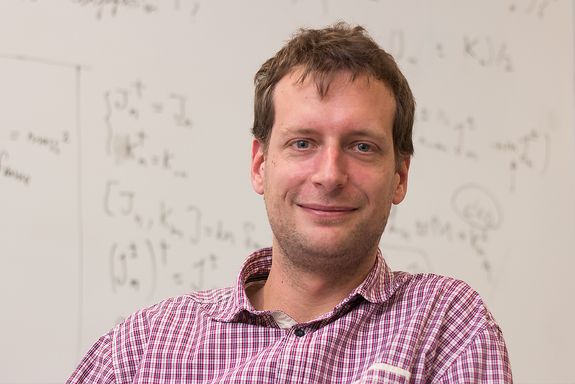These are the fundamental laws of the universe: with quantum physics formulae, nearly everything can be calculated - at least theoretically. However, in practice, calculations soon come up against barriers. Only for the simplest of systems that consist of very few particles can formulae be solved accurately. Even for simple molecules with just a few electrons, the calculation becomes so complicated that even the best supercomputer is hopelessly overwhelmed.
Scientists therefore need to come up with smart strategies to achieve approximate solutions that are as good as possible with as little as possible effort. It is these approximation procedures for multi-particle problems in quantum physics that are the focus of the work of Professor Andreas Grüneis, who moved from Stuttgart to the Institute of Theoretical Physics at TU Wien in July 2017. Not only did he bring his team to Vienna, he also brought an ERC Starting Grant - one of the most prestigious research awards available in Europe.
Quantum particles are not desk lamps
In our everyday life, it is fairly easy for us to describe a variety of objects, by considering them as separate from each other. The place where the coffee table sits in the living room is completely independent of the position of the desk lamp. However, in quantum physics, this issue is much more complex: "In systems known as highly correlated systems, it makes no sense to describe particles separately from each other," explains Andreas Grüneis. "If you measure an electron at a certain location, this has an instant impact on the likelihood with which the other electrons stay in certain locations."
If you want to measure the position of three desk lamps instead of the position of one desk lamp, that takes three times as long, and requires three times as much storage space to note the result. However, in quantum systems, the effort and storage requirement increases exponentially with the number of particles. Calculating the electronic state of a simple molecule such as methane quickly takes cutting-edge high-performance computers to the limits of their potential. Exact calculations of larger systems, say solid states, are completely impossible. To achieve this would require more storage capacity than is available in the whole world.
But there is a way forward: "We can find mathematical methods to simplify the problem," says Andreas Grüneis. "This would no longer give us exactly the right result, but if we get it right, a result can be obtained in many cases that would come very close to the truth."
Grüneis compares these procedures with images on a computer: if you store a holiday photo in the best possible quality, it takes up as much storage space as a whole bookshelf of texts. However, image processing programs can use mathematical tricks to store a lot in a small space - the output differs very slightly from the original, but with the naked eye, you can hardly see the difference, and the simplified version completely satisfies most requirements.
Materials science has long been searching for solution procedures for multi-particle systems - in fact, Walter Kohn, a US physicist originally from Vienna, was awarded a Nobel prize for the development of density functional theory. This field works directly at the interface of physics, chemistry and computer science.
The questions about how we want to research new approximation calculation methods are virtually limitless: How do chemical reactions take place? Which materials can be used as catalysts? What properties do materials have under extreme conditions, such as hydrogen on Jupiter? Computer simulations can answer these questions to some extent, or they can help us to interpret experiments.
"Multi-particle quantum physics has experienced something of a boom in recent years, because modern computers and calculation methods now finally give us the opportunity to tackle many key problems which appeared to be incalculable decades ago," says Grüneis.
Vienna, Cambridge, Stuttgart, Vienna
Andreas Grüneis is originally from Hörsching in Upper Austria. He studied physics at the University of Vienna, where he was also awarded his doctorate in 2011. Since then, he has been focusing on numeric multi-particle quantum physics. He then moved to Cambridge to take up a postdoctoral position, where he worked on the "Coupled Cluster Method" which remains a key element of his research work today. With a grant from the Austrian Academy of Sciences, he returned to Vienna and in 2015, became team leader at the Max Planck Institute for Solid State Research in Stuttgart. In 2016, he was awarded an ERC Starting Grant by the European Research Council. Since July 2017, he has held the post of professor at TU Wien.
Andreas Grüneis was pleased to return to Vienna with his wife and two children - for academic as well as personal reasons: "Vienna is without a doubt one of the world's major cities when it comes to numerical quantum physics," says Grüneis. "There is so much high-quality research in this field here and I am looking forward to exciting new ideas and cooperation opportunities."
